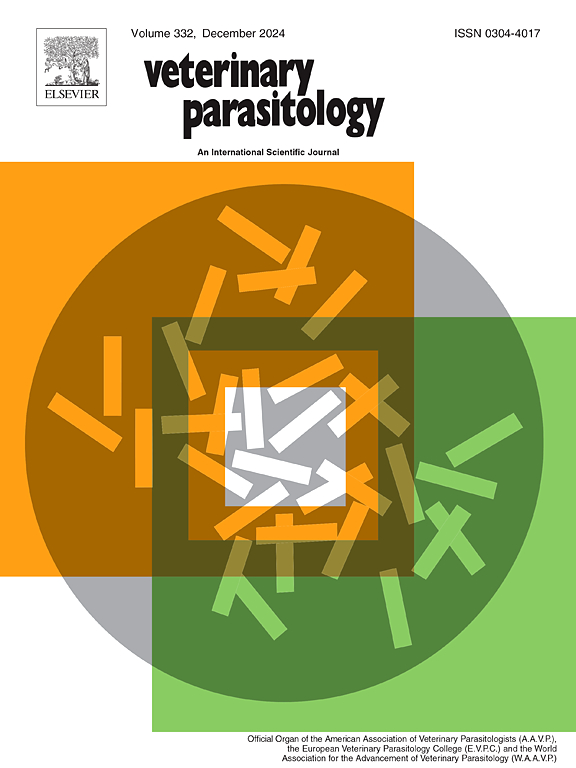TFinder App: Artificial intelligence to diagnose tick fever agents and assess parasitemia/bacteremia in bovine blood smears
IF 2
2区 农林科学
Q2 PARASITOLOGY
引用次数: 0
Abstract
Due to the importance of diagnosing tick fever (TF) agents and their parasitemia in the field to provide appropriate treatment, the objective of this study was to develop an application capable of detecting the presence or absence of these hemopathogens and calculating parasitemia/bacteremia. Therefore, to create the TFinder app, blood smears from the tip of the tail of cattle naturally infected with TF were prepared to train the artificial neural network (ANN) for Anaplasma marginale and Babesia spp. The ANN was trained with images from different microscope fields and angles. For the validation stage of the ANN, new blood smear images from different animals were inserted. The diagnosis of presence or absence and calculation of parasitemia/bacteremia performed by a human being were compared with that of the ANN. The ANN was trained with 8100 and 2871 images of blood smears containing parasitized erythrocytes with A. marginale and Babesia spp. respectively. In the validation stage, it was used a total of new 1000 for A. marginale and 750 for Babesia spp. There was a strong positive correlation between the A. marginale bacteremia (r = 0.9484; R² = 0.8996; p < 0.0001) values obtained by the human and TFinder app, the same occurred for Babesia spp. parasitemia (r = 0.9650; R² = 0.9314; p < 0.0001). The sensitivity, specificity, and accuracy of TFinder app for the presence or absence of A. marginale were 97.7 %, 86.5 %, and 95.4 %, respectively. While for A. marginale bacteremia it was 89.6 %, 98.7 %, and 98.1 %, respectively. For Babesia spp., the sensitivity, specificity, and accuracy of presence and absence were 98.0 %, 91.1 %, and 96.9 %, respectively. The calculation of Babesia spp. parasitemia was 84.3 %, 99.7 % and 98.9 %, respectively. TFinder app can be used to diagnose and calculate the parasitemia/bacteremia of TF agents in bovine blood smear images.
TFinder应用程序:用于诊断蜱热病原体和评估牛血液涂片中的寄生虫病/菌血症的人工智能
由于诊断蜱热(TF)病原体及其寄生虫血症在现场提供适当治疗的重要性,本研究的目的是开发一种能够检测这些病原体存在或不存在并计算寄生虫血症/菌血症的应用程序。因此,为了开发TFinder应用程序,我们准备了自然感染TF的牛尾尖的血液涂片,并使用不同显微镜视场和角度的图像训练人工神经网络(ANN)来识别边缘无形体和巴贝斯虫。在人工神经网络的验证阶段,我们插入了不同动物的血液涂片图像。并与人工神经网络的诊断结果进行比较。该人工神经网络分别用8100张和2871张寄生有边缘拟虫和巴贝斯虫的红细胞血涂片图像进行训练。在验证阶段,边沿棘球绦虫和巴贝斯虫的菌量分别为1000和750,边沿棘球绦虫菌量与边沿棘球绦虫菌量呈正相关(r = 0.9484;R²= 0.8996;p <; 0.0001)值与人类和TFinder应用程序获得的值相同,巴贝斯虫寄生虫病(r = 0.9650;R²= 0.9314;p & lt; 0.0001)。TFinder应用程序对边缘芽孢杆菌存在与否的敏感性、特异性和准确性分别为97.7% %、86.5 %和95.4% %。边缘芽孢杆菌血症分别为89.6% %、98.7% %和98.1% %。对巴贝斯虫的存在、不存在的敏感性为98.0 %,特异性为91.1 %,准确性为96.9 %。巴贝斯虫寄生率分别为84.3 %、99.7 %和98.9 %。TFinder应用程序可以诊断和计算牛血液涂片图像中TF药物的寄生虫血症/菌血症。
本文章由计算机程序翻译,如有差异,请以英文原文为准。
求助全文
约1分钟内获得全文
求助全文
来源期刊

Veterinary parasitology
农林科学-寄生虫学
CiteScore
5.30
自引率
7.70%
发文量
126
审稿时长
36 days
期刊介绍:
The journal Veterinary Parasitology has an open access mirror journal,Veterinary Parasitology: X, sharing the same aims and scope, editorial team, submission system and rigorous peer review.
This journal is concerned with those aspects of helminthology, protozoology and entomology which are of interest to animal health investigators, veterinary practitioners and others with a special interest in parasitology. Papers of the highest quality dealing with all aspects of disease prevention, pathology, treatment, epidemiology, and control of parasites in all domesticated animals, fall within the scope of the journal. Papers of geographically limited (local) interest which are not of interest to an international audience will not be accepted. Authors who submit papers based on local data will need to indicate why their paper is relevant to a broader readership.
Parasitological studies on laboratory animals fall within the scope of the journal only if they provide a reasonably close model of a disease of domestic animals. Additionally the journal will consider papers relating to wildlife species where they may act as disease reservoirs to domestic animals, or as a zoonotic reservoir. Case studies considered to be unique or of specific interest to the journal, will also be considered on occasions at the Editors'' discretion. Papers dealing exclusively with the taxonomy of parasites do not fall within the scope of the journal.
 求助内容:
求助内容: 应助结果提醒方式:
应助结果提醒方式:


